Quick Airline Information:
✈Airline IATA* code: LH
✈Airline ICAO* code: DLH ✈Founded: 6 January 1953, former Deutsche Luft Hansa since 1926.
✈Website: www.lufthansa.com✈Alliance: Star Alliance✈History
✈Operations and Destinations 🌍
✈Fleet ✈️
✈Photo Slide 📷✈Safety Video 🎬
✈Airline reviews ⭐
*IATA: (International Air Transport Association)
*ICAO: (International Civil Aviation Organization)
History Menu:
The German airline is one of the oldest airlines in Europe, and has been one of the pioneers in aviation ever since its formation back in 1926. Not only it has grown to be one of the major airlines in Europe, but also it helped establish many other airlines around the world, leasing and building capital to give the necessary backup until airlines could fly alone.
To learn more about the legacy of this incredible company, we need to travel back in time to the very early days of flying when Deutsche Luft Hansa was founded on 6 January 1926 in Berlin. The name of the company was a combination of "Deutsche Luft" ("German Air") and "Hansa" (after the Hanseatic League, a powerful mediaeval trading group).
The airline was created by a merger between Deutscher Aero Lloyd (an airline formed in 1923 out of the earlier airline Deutsche Luft-Reederei (DLR, the stylised flying crane symbol comes from this airline) by AEG, Luftschiffbau Zeppelin and Dornier as a co-operation between the shipping companies Norddeutscher Lloyd and Hamburg America Line) and Junkers Luftverkehr, the in-house airline of Junkers.
This action was taken due to an initiative of the German government which hoped to reduce the amount of financial support it provided to the two partly state-owned airlines, which were both plagued by heavy debts at that time. The initial fleet consisted of 162 aircraft, nearly all of them outdated World War I types, The most important airfield for DLH was Berlin Tempelhof. From there a Fokker F.II took off on 6 April 1926 for the first scheduled flight to Zürich via Halle, Erfurt and Stuttgart.
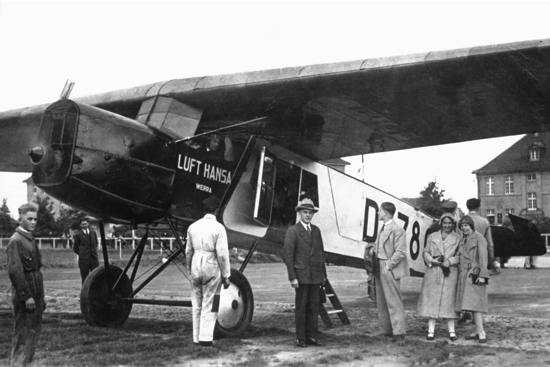
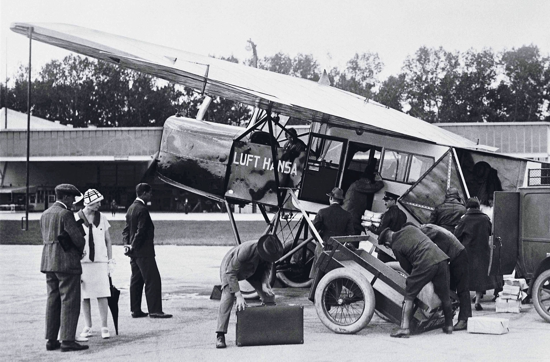
In the same year, 1926, the airline launched non-stop flights from Berlin to Moscow, which was then regarded as an exceptionally long distance. Shortly after that flights to Paris were commenced. Deutsche Luft Hansa was one of the first airlines to operate night flights, the first of which connected Berlin with Königsberg, in 1928, using Junkers G 24 aircraft. This route proved so successful that the night train connection was discontinued some years later.
Over the following years, the domestic network grew to cover all the important cities and towns of Germany. More international routes were added through co-operation agreements. With the newly founded Iberia in Spain its longest scheduled route was 2,100 kilometres from Berlin to Madrid (though with several stopovers). The establishment of Syndicato Condor in Brazil served the airline's interests in South America where there were important German minorities at that time.
The first East-West crossing of the Atlantic Ocean (from Baldonnel Aerodrome in Ireland to Greenly Island, Canada) was made by Luft Hansa using the Junkers W 33 aircraft Bremen in April 1928. The airline also launched scheduled multi-leg flights to Tokyo.
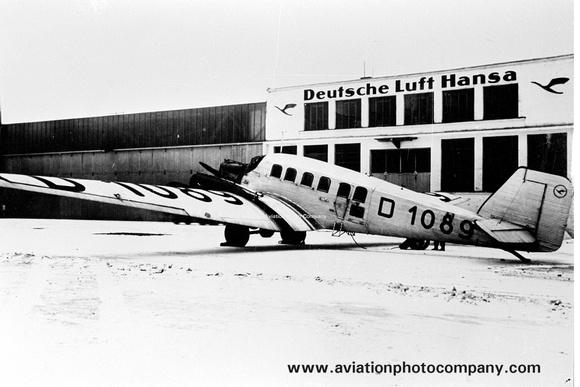
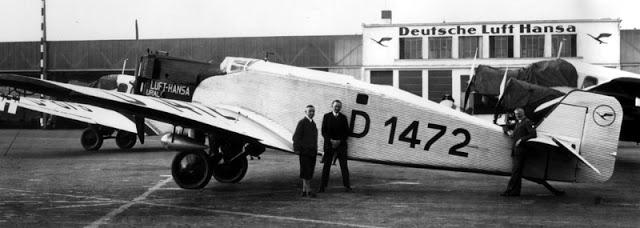
By the 1930’s, even though the early years of the decade saw a difficult financial situation due to the Great Depression, Deutsche Luft Hansa further expanded its international route network in South America, and launched scheduled flights from Germany to the Middle East. Politically, the company leaders were linked to the rising Nazi Party; an aircraft was made available to Adolf Hitler for his campaign for the 1932 presidential election free of any charge.
A record was set in 1930 when the mail route from Vienna to Istanbul (with stopovers in Budapest, Belgrade and Sofia) was completed in only 24 hours. By comparison, the first transatlantic passenger flight by the airline (from Warnemünde to New York City using a Dornier Wal flying boat) took roughly one week.
After several years of testing, the first scheduled postal route between Europe and South America was inaugurated in 1934. It started with Wal flying boats, then replaced by the Dornier Do-18 in 1936 making operations in non-visual conditions possible. The European network saw the introduction of the Junkers G.38 (at that time the largest passenger aircraft in the world) on the Berlin-London route via Amsterdam, as well as the Junkers Ju 52/3m and Heinkel He 70, which allowed for faster air travel. In 1935, the first aircraft not manufactured in Germany were introduced into the fleet: two Boeing 247s and one Douglas DC-2.
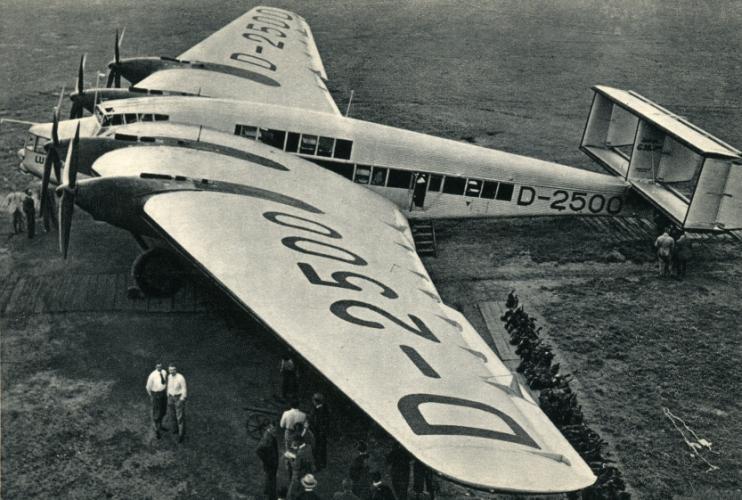
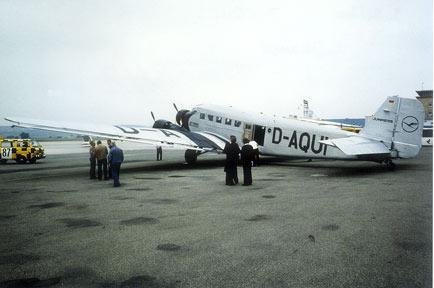
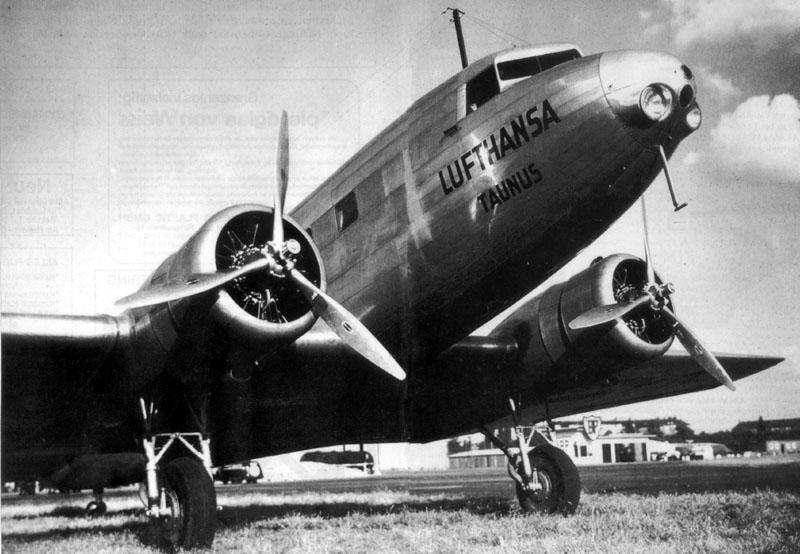
The expansion in the domestic South American markets continued in 1937, when the Sociedad Ecuatoriana de Transportes Aéreos(SEDTA) and Lufthansa Perú were founded as Luft Hansa co-operations in Ecuador and Peru respectively, operating Junkers W 34 aircraft. In 1938 the Focke-Wulf Fw 200 long range aircraft was introduced making it possible to fly non-stop between Berlin and New York and from Berlin to Tokyo with only one intermediate stopover. On 1 April 1939, Deutsche Luft Hansa launched scheduled transatlantic flights between Port Natal, South Africa and Santiago de Chile using Fw 200 aircraft. With Bangkok, Hanoi and Taipei, further Asian destinations were added to the route network.
With the outbreak of the WW II on 1 September 1939 all civilian flight operations of Luft Hansa came to an end, and the aircraft fleet came under command of the Luftwaffe, along with most staff. The company then focused on aircraft maintenance and repair Like most enterprises in Germany during the war. There were still scheduled passenger flights within Germany and to occupied or neutral countries, but bookings were restricted and served the demands of warfare. During the later years of the war, most passenger aircraft were converted to military freighters.
The Luft Hansa co-operations in foreign countries were gradually dismantled, during the early 1940’s. With the war turning back on Germany, and having lost extensively many of its airframes, the assets of the airline were minimum and was loosing confidence amongst its passengers and staff. The last scheduled flight of Deutsche Luft Hansa - from Berlin to Munich took place on 21 April 1945, but the aircraft crashed shortly before the planned arrival. Following the surrender of Germany and the ensuing Allied occupation of Germany, all aircraft in the country were seized and Deutsche Luft Hansa was dissolved. The remaining assets were liquidated on 1 January 1951.
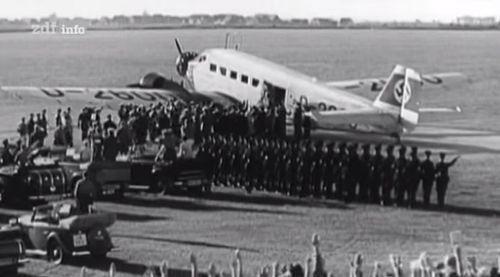
After the war and with the reconstruction of Germany taking place, new businesses starting to appear; a company called Aktiengesellschaft für Luftverkehrsbedarf (Luftag), was founded in Cologne on 6 January 1953, with many of its staff having worked for the pre-war Lufthansa. West Germany had not yet been granted sovereignty over its airspace, so it was not known when the new airline could become operational. Nevertheless, in 1953 Luftag placed orders for four Convair CV-340s and four Lockheed L-1049 Super Constellations and set up a maintenance base at Hamburg Airport.
On 6 August 1954, Luftag acquired the name and logo of the liquidated Deutsche Lufthansa for DM 30,000 (equivalent to € 35000 today). It enabled the continuation of the tradition of the German flag carrier of that name. On 1 April 1955 Lufthansa won approval to start scheduled domestic flights, linking Hamburg, Düsseldorf, Frankfurt, Cologne, and Munich. International flights started on 15 May 1955, to London, Paris, and Madrid, followed by Super Constellation flights to New York City from 1 June of that year, and across the South Atlantic from August 1956.
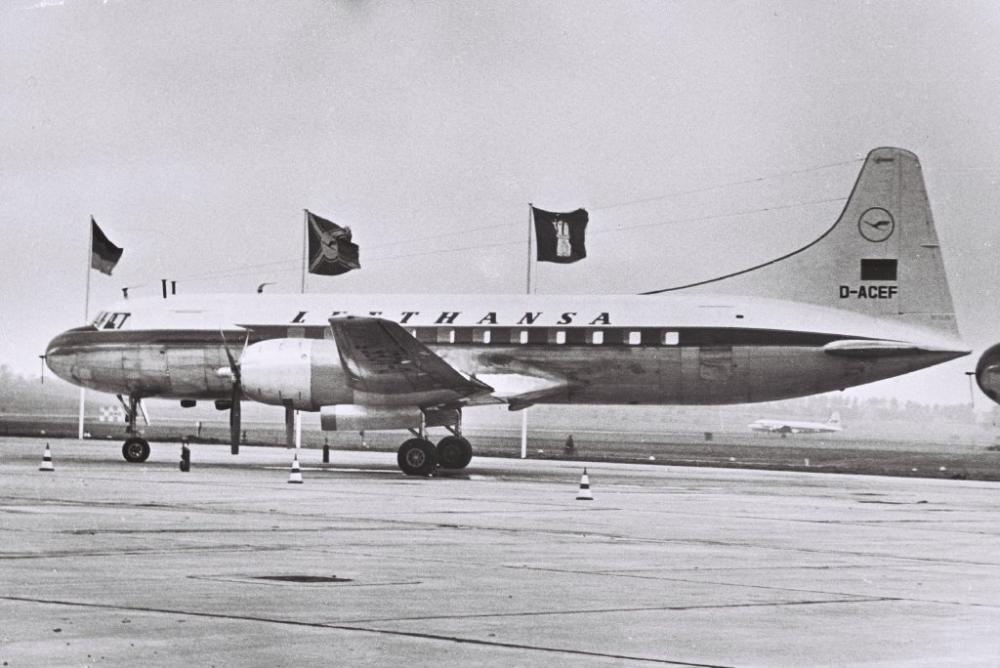
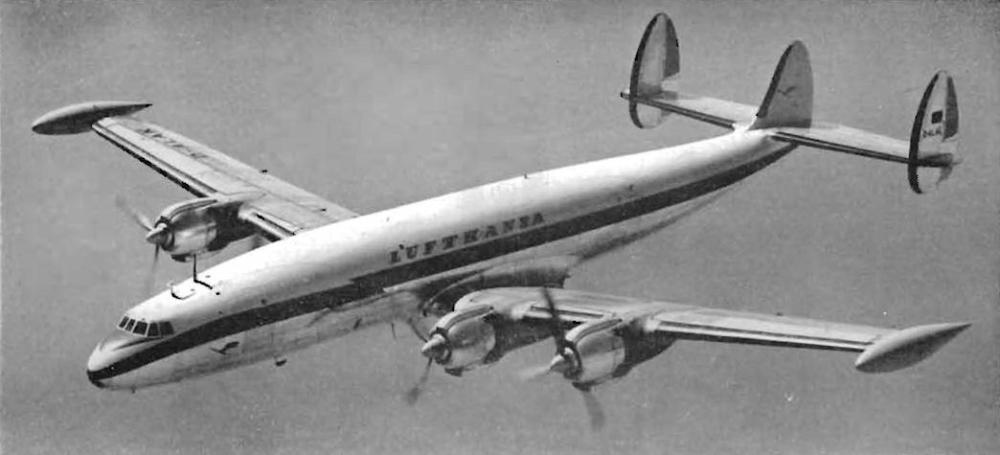
After the initial expansion and re--growth of the airline, Lufthansa was ready to take on new marketing strategies and growth developments. In 1958, the airline initiated a marketing campaign to sell itself and West Germany. The challenges involved encouraging travellers to consider visiting the country in the wake of World War II. By 1963, the airline, had become a major seller of West Germany’s image abroad. The special status of Berlin meant that Lufthansa was not allowed to fly to either part of Berlin until 1989. Originally thought to be only a temporary matter (and with intentions to move the airline's headquarters and main base there once the political situation changed), the Division of Germany turned out to be long, which gradually led to Frankfurt Airport becoming Lufthansa's primary hub.
East Germany tried to establish its own airline in 1955 using the Lufthansa name, but this resulted in a legal dispute with West Germany, where Lufthansa was operating. East Germany instead established Interflug as its national airline in 1963, which coincided with the East German Lufthansa being shut down. Interflug started operations using mostly soviet airliners, including the Ilyushin Il-14 (pictured),
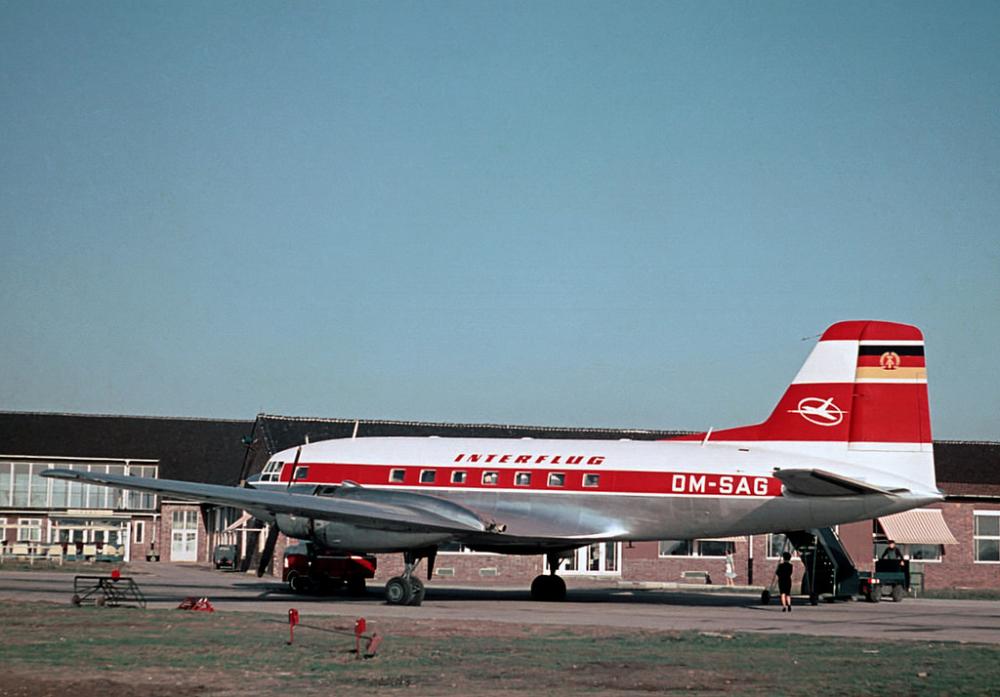
In 1958 Lufthansa ordered four Boeing 707s and started jet flights from Frankfurt to New York City in March 1960. Boeing 720B's were later bought to back up the 707 fleet. In February 1961 Far East routes were extended beyond Bangkok, Thailand, to Hong Kong and Tokyo. Lagos, Nigeria and Johannesburg, South Africa were added in 1962.
Lufthansa introduced the Boeing 727 in 1964. Also that year in May began the Polar route from Frankfurt to Tokyo via Anchorage. In February 1965 the company ordered twenty-one Boeing 737s that went into service in 1968. Lufthansa was the first customer for the Boeing 737 and was one of four buyers of the 737-100s. Lufthansa was the first foreign launch customer for a Boeing airliner.
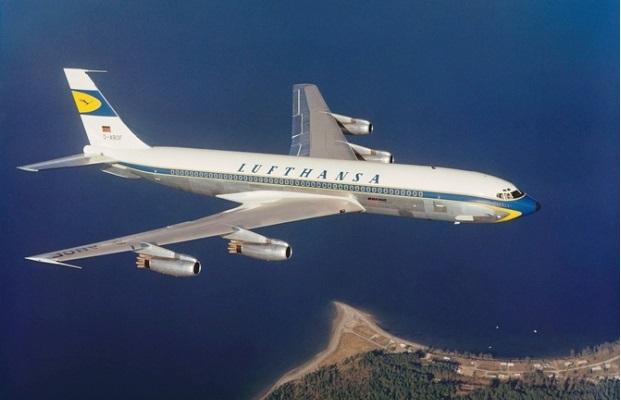
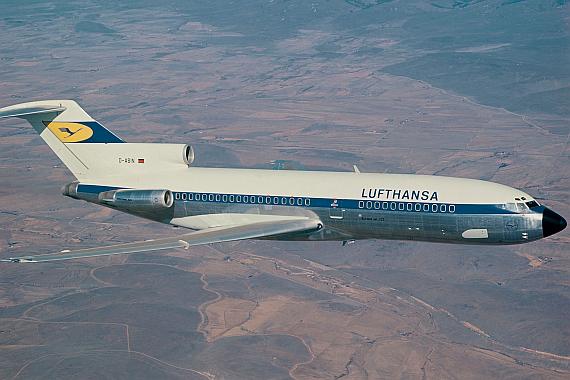
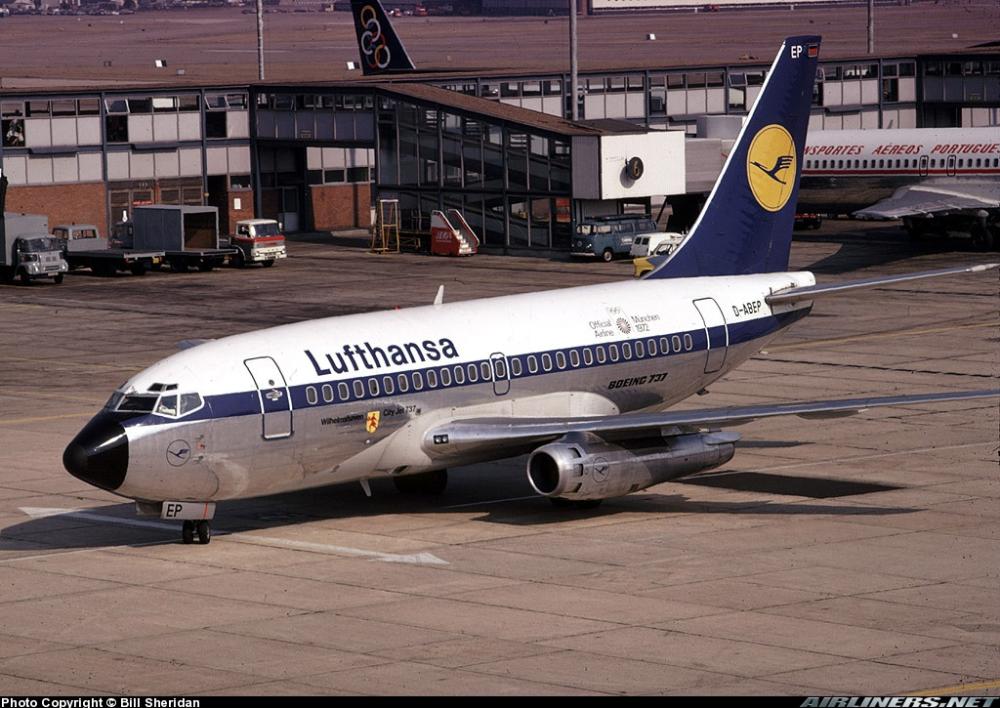
The wide-body era for Lufthansa started with the Boeing 747 on April 26, 1970. It was followed by the introduction of the DC-10-30 on November 12, 1973, and the first Airbus A300 in 1976. In 1979 Lufthansa and Swissair were launch customers for the Airbus A310 with an order for twenty-five aircraft.
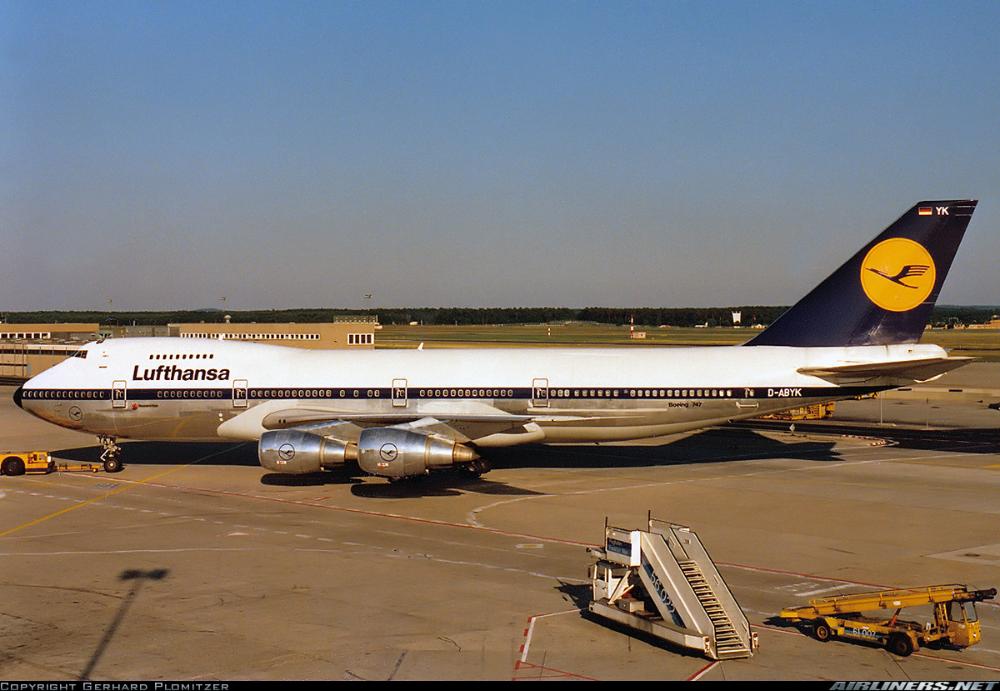
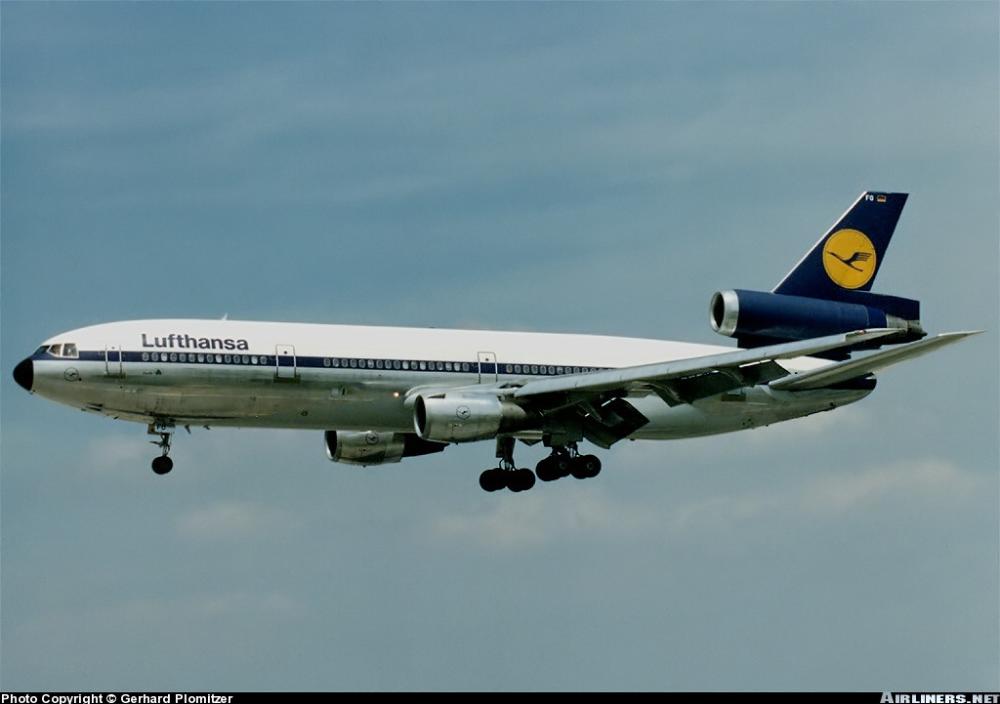
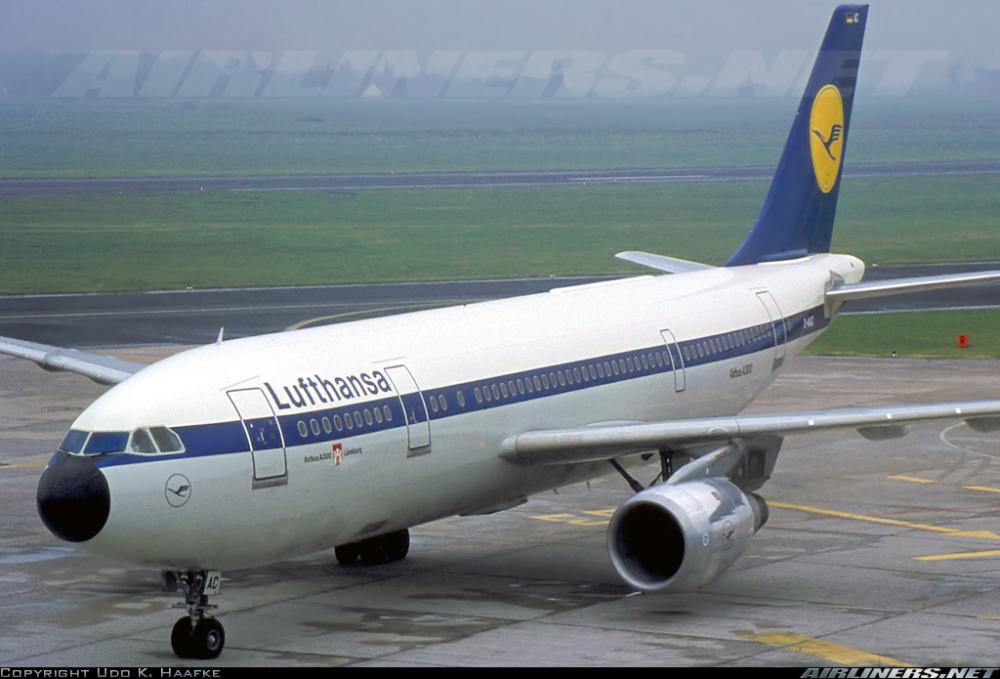
The company's fleet modernisation programme for the 1990s began on June 29, 1985 with an order for fifteen Airbus A320s and seven Airbus A300-600s. Ten Boeing 737-300s were ordered a few days later. All were delivered between 1986 and 1992.
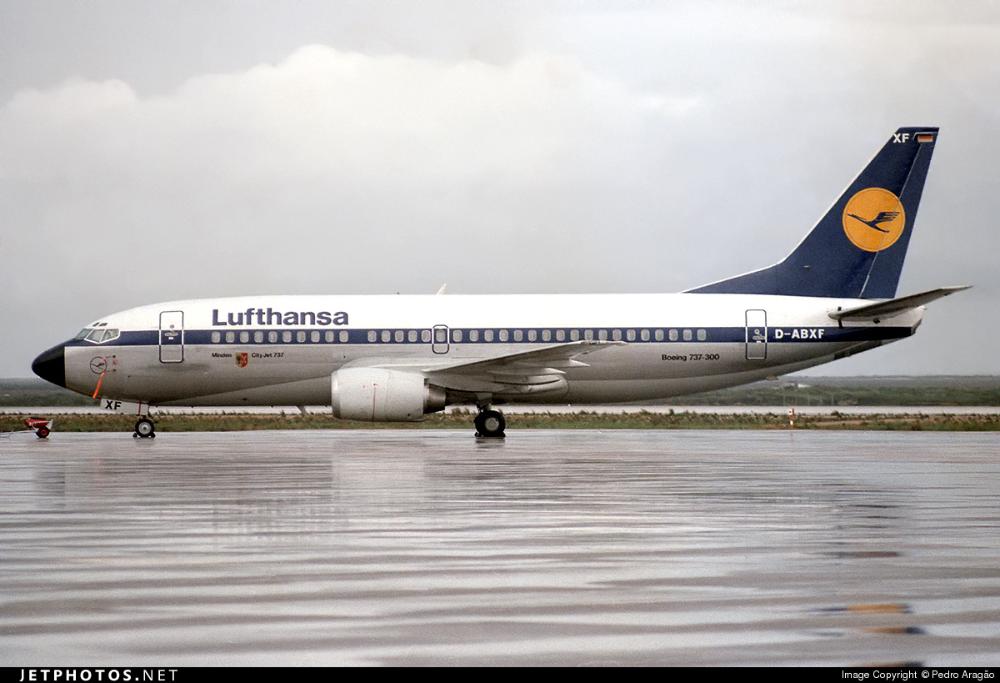
Lufthansa also bought Airbus A321, Airbus A340, and Boeing 747-400 aircraft. In 1987 Lufthansa, together with Air France, Iberia, and Scandinavian Airlines, founded Amadeus, an IT company (also known as a GDS) that would enable travel agencies to sell the founders and other airlines' products from a single system. Lufthansa adopted a new corporate identity in 1988, as well as the livery on its aircraft. The blue window band was removed and the bottom part of the fuselage and engines were now painted in light grey, while cabins, city offices, and airport lounges were redesigned and updated also.
On October 28, 1990, 25 days after reunification, Berlin became a Lufthansa destination again. On May 18, 1997, Lufthansa, Air Canada, Scandinavian Airlines, Thai Airways International, and United Airlines formed Star Alliance, the world's first multilateral airline alliance.
.jpg)
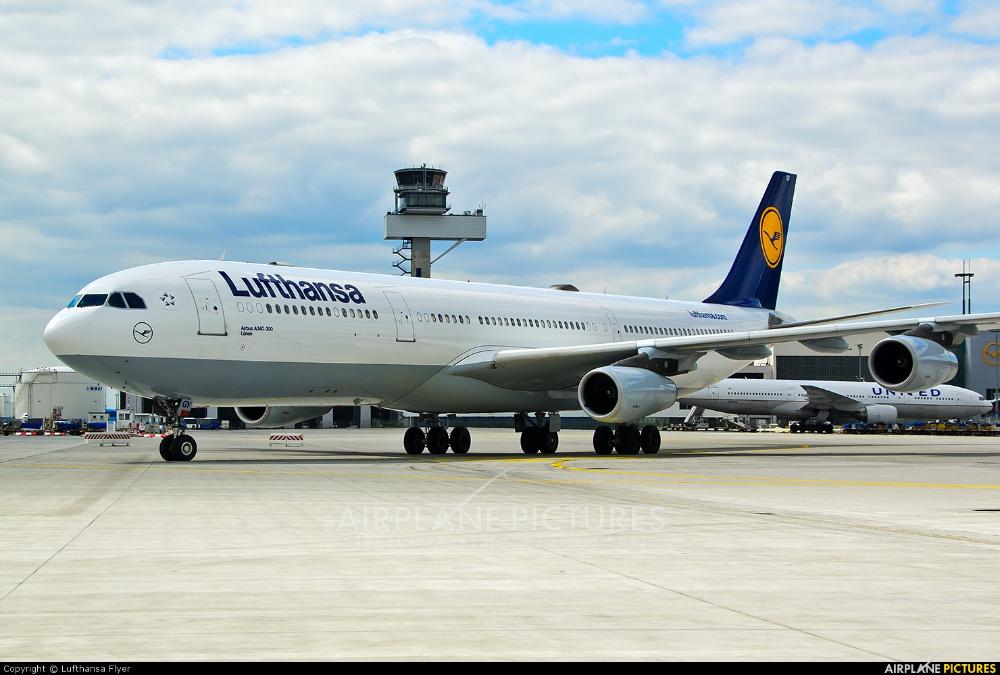
In 2000, Air One became a Lufthansa partner airline and nearly all Air One flights were code-shared with Lufthansa until Alitalia purchased Air One. Lufthansa has a good track record for posting profits, even in 2001, after 9/11, the airline suffered a significant loss in profits but still managed to stay 'in the black'. While many other airlines announced cuts to staff, Lufthansa retained its current workforce. On December 6, 2001, Lufthansa announced an order for 15 Airbus A380 superjumbos with 10 more options. The A380 fleet will be used for long-haul flights from Frankfurt exclusively.
In June 2003, Lufthansa opened Terminal 2 at Munich's Franz Josef Strauß Airport to relieve its main hub, Frankfurt, which was suffering from capacity constraints. It is one of the first terminals in Europe partially owned by an airline. On March 22, 2005, Swiss International Air Lines was purchased by Lufthansa's holding company. The two companies will continue to be run separately. On December 6, 2006, Lufthansa placed an order for 20 Boeing 747-8s, becoming the launch customer of the passenger model. The airline is also the second European airline to operate the Airbus A380 (after Air France).
In September 2008, Lufthansa Group announced its intent to purchase a stake in Brussels Airlines (SN). (Later in January 2018, Lufthansa announced it would purchase the remainder of Brussels Airlines). In September 2009, Lufthansa purchased Austrian Airlines with the approval of the European Commission.
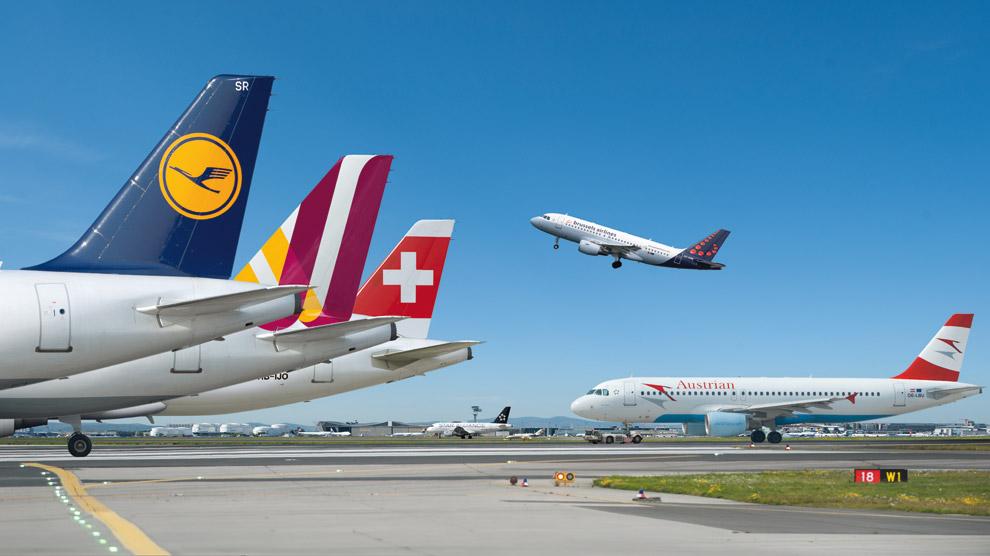
The first A380 was delivered on 19 May 2010 and on the 11 of June 2010, Airbus A380 services between Frankfurt and Tokyo started. While the first 747-8 entered service in 2012. However, after the period of consolidation and airline buyouts, during 2010, the airline posted a loss of 381 million euros in the first quarter of 2010 and another 13 million loss in the year 2011, also due to the economic recession. Deutsche Lufthansa decided to cut 3,500 administrative positions and begin a turn around plan in order to bring it back to the black.
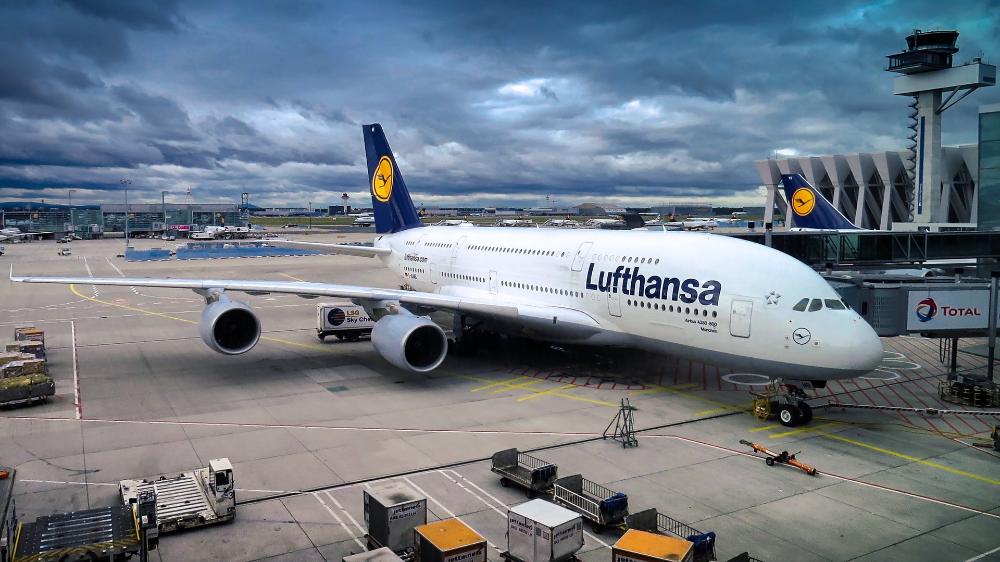
From 2011, the airline saw its competition grow, and the introduction of low cost airlines into domestic markets made it even harder for the airline to survive at its present rate. As a part of the restructuring plan the company started to transfer all short-haul flights outside its hubs in Frankfurt, Munich and Düsseldorf to the company’s re-branded low-cost carrier Germanwings.
In September 2013 Lufthansa Group announced its biggest order, for 59 wide-body aircraft. Earlier in the same year Lufthansa placed an order for 100 next-generation narrow-body aircraft.
.jpg)
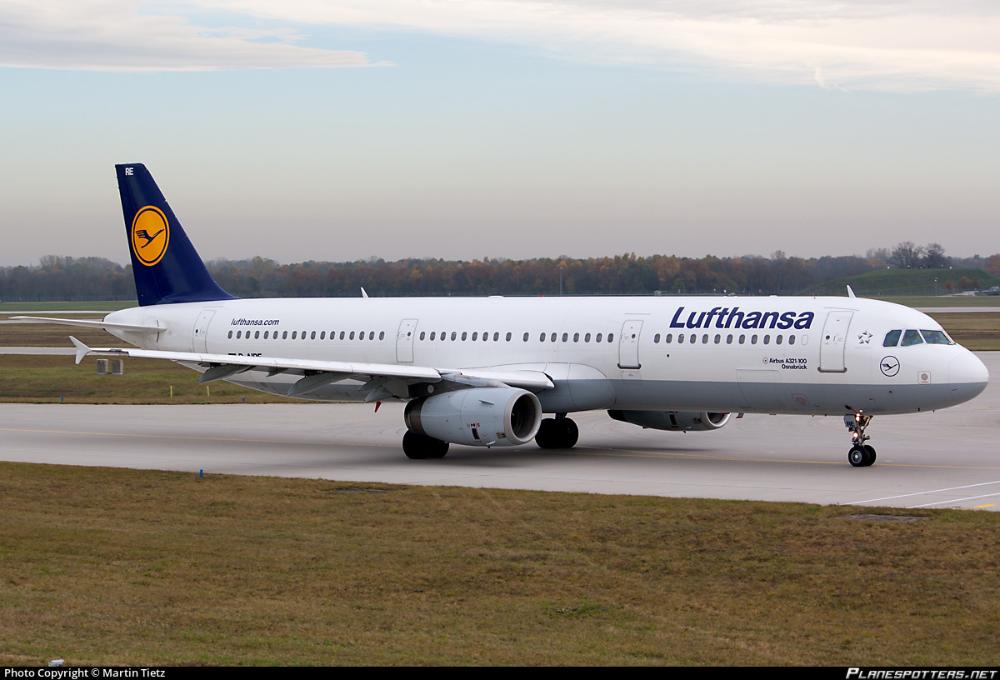
In June 2015, Lufthansa announced plans to close its small long-haul base at Düsseldorf Airport for economic reasons by October 2015. At the time, the base consisted of two Airbus A340-300s rotating between Newark and Chicago. As a result, service to Chicago from Düsseldorf was first made seasonal and then cancelled altogether.Service to Newark, however, has been maintained.
On the 1 of November 2015, the launch of the new Eurowings, the low cost airline started Intercontinental flights out of Cologne-Bonn Airport with transferred Airbus A330 from Lufthansa. The first services flew to the Caribbean, Dubai and Thailand. The rest of the fleet of Airbus A320 and A319 also will rebrand as Eurowings.
In January 2016, another chapter in the airline's fleet was made when it received the first A320neo. The new plane has new engines and improved aerodynamics which have made significant progress in terms of noise and emission reduction possible. Lufthansa ordered a total of 116 aircraft of the A320neo family. Later that year, on 22 of March 2016, Lufthansa ended Boeing 737-500 operations. The airline's last Boeing 737 (a 737-300) was retired on 29 October 2016, after a flight from Milan to Frankfurt. At the end of December 2016, Lufthansa acquired the first A350-900 in Hamburg. The twin-engine long-haul aircraft started to replace older Airbus A330/A340 and Boeing 747.
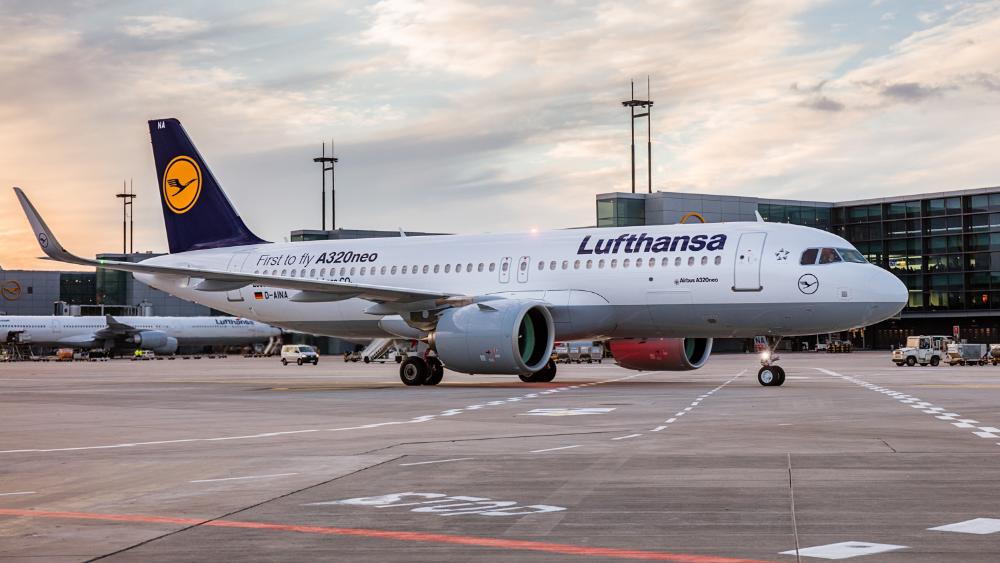
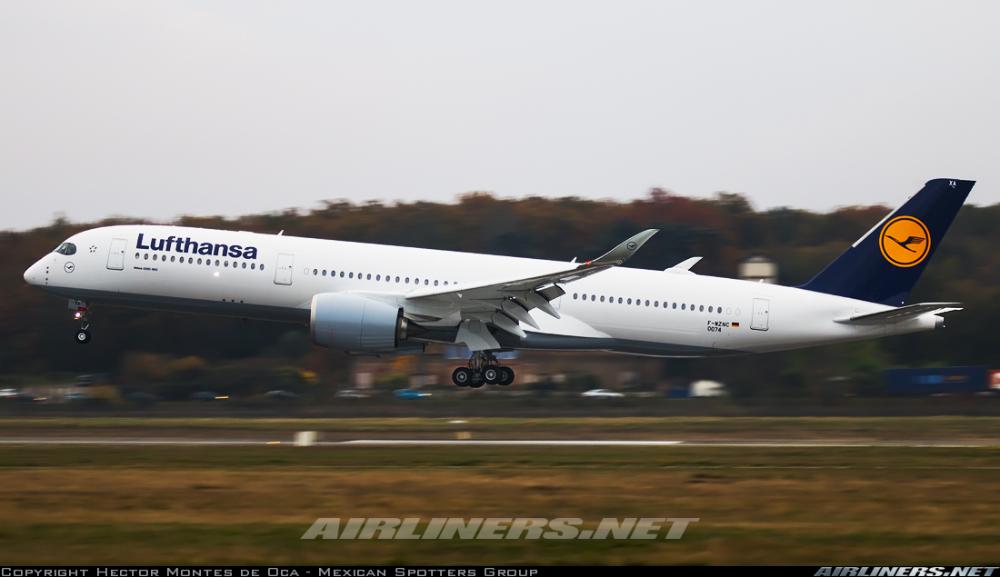
On 4 December 2017, Lufthansa became the first European airline to receive the prestigious Skytrax 5 star certification. After expressing its interest in SN Brussels Airlines 10 years back, in January 2018, Lufthansa exercised its option to purchase the remaining 55 per cent of the shares and take over 100 per cent of SN Airholding. Brussels Airlines would be fully integrated into the Lufthansa Group from 2018 and fly under the roof of the Eurowings Group.
The 7 February 2018, marked yet another important milestone for the airline, as Lufthansa presented a new brand design, modernized yet still retained the traditional crane symbol. The most visible sign of this change is the new paint scheme for the aircraft. A darker blue becomes the leading brand color. The Lufthansa crane, was revised, above all with a view to the requirements of the digital age. The new Lufthansa appearance show its modern quality and sharpened effects.
.jpg)
From 2020, Lufthansa will also receive the first highly efficient Boeing 777-9 long-haul aircraft, in which the new Business Class will be used for the first time, all passengers in the new Business class will have direct access to the aisle. This is made possible by a 1-2-1 and 1-1-1 seat configuration. They replace the Airbus A340-600 and other Boeing 747-400 currently in service till then.
History source: Wikipedia.org + Lufthansa.com
Operations and Destinations 🌍:
The German airline is not only the main operating airline in Germany, but has become a recognised brand all over Europe, where it controls the operations of a number of other European Airlines, including Swiss International Airlines, Austrian Airlines or Brussels Airlines in their respective countries. In addition it also controls Eurowings, it’s low cost subsidiary with all flights out of secondary airports in Germany (Not Munich or Frankfurt where the main Lufthansa operates from). Lufthansa alone flies to 18 domestic and 193 international destinations in over 80 countries worldwide.
Lufthansa has also control over Air Dolomiti and Lufthansa CityLine, which is its regional airline based at Munich Airport. The main bases are Frankfurt and Munich , where the airline concentrates most of its connecting operations and long haul flights to all over the world. Dusseldorf is the only exception with direct flights to New York operated by Lufthansa.
Below are the destinations* served by Lufthansa, including those by its regional airline, Lufthansa CityLine, but excluding routes served by partner airlines or associated airlines:
| Region 🗺️ | Destinations 🌍🌎🌏 |
|---|---|
| ✈Germany (domestic) | Berlin, Bremen, Cologne/Bonn, Dresden, Düsseldorf, Frankfurt, Friedrichshafen, karlsruhe, Hamburg, Hanover, Heringsdorf, Leipzig/Halle, Munich, Münster, Nuremberg, Paderborn, Rostock, Saarbrucken, Stuttgart, Westerland |
| ✈Europe | Aalborg, Alicante, Amsterdam, Ancona, Antalya, Athens, Barcelona, Bari, Basel-Mulhouse-Freiburg, Bastia, Belgrade, Bergen, Biarritz, Bilbao, Billund, Birmingham, Bodrum/Milas, Bologna, Bordeaux, Brussels, Bucharest, Budapest, Cagliari, Cardiff, Catania, Chişinău, Cluj-Napoca, Copenhagen, Dublin, Dubrovnik, Edinburgh, Faro, Florence, Gdańsk, Geneva, Genoa, Glasgow, Gothenburg, Graz, Helsinki, Heraklion, Ibiza, Innsbruck, Inverness, Istanbul, Izmir, Jersey, Katowice, Kiev, Kittilä, Knock, Kraków, Lamezia Terme, Larnaca, Lisbon, London (LHR, LGW, LCY), Lublin, Luqa, Luxembourg City, Lviv, Lyon, Madrid, Málaga, Manchester, Marseilles, Milan, Milan, Minsk, Montpellier, Moscow, Nantes, Naples, Newcastle upon Tyne, Newquay, Nice, Odessa, Olbia, Oslo, Palermo, Palma de Mallorca, Paris, Pisa, Porto, Poznań, Prague, Reykjavík, Riga, Rijeka, Rimini, Rome, Rzeszów, Saint Petersburg, Sarajevo, Shannon, Sibiu, Sofia, Split, Stavanger, Stockholm, Tallinn, Tbilisi, Timisoara, Tirana, Tivat, Toulouse, Trieste, Tromsø, Turin, Valencia, Venice, Verona, Vienna, Vilnius, Warsaw, Wroclaw, Zadar, Zagreb, Zürich |
| ✈North America | Atlanta, Austin, Boston, Charlotte, Chicago, Dallas/Fort Worth, Denver, Detroit, Houston, Los Angeles, Miami, New York City, Newark, Orlando, Philadelphia, San Diego, San Francisco, Seattle, Tampa, Washington, D.C., Montreal, Toronto, Vancouver |
| ✈Central and South America | Bogota, Buenos Aires, Cancún, Mexico City, Panama City, Rio de Janeiro, San José, São Paulo |
| ✈Asia | Almaty, Ashgabat, Astana, Baku, Bangalore, Bangkok, Beijing, Chennai, Delhi, Hong Kong, Malé, Mumbai, Nagoya, Nanjing, Osaka, Port Louis, Pune, Qingdao, Seoul, Shanghai, Shenyang, Singapore, Tokyo |
| ✈Middle East | Amman, Beirut, Dammam, Dubai, Eilat, Erbil, Jeddah, Kuwait City, Manama, Riyadh, Tehran, Tel Aviv |
| ✈Africa | Abuja, Addis Ababa, Algiers, Cairo, Cape Town, Casablanca, Johannesburg, Lagos, Luanda, Malabo, Marrakech, Mauritius, Nairobi, Port Harcourt, Tunis |
*Destination list is for reference only. Please check directly with the airline for updates.
*Note some destinations are only seasonal.*Correct info as of Feb 2019.
Fleet ✈️:
With a fleet of over 340 planes, Lufthansa is one of the biggest airlines in Europe, operating direct flights to 4 continents. It has always been at the head of innovation, design and technology, partnering with aircraft manufacturers like Airbus or Boeing to develop, safer, more reliable and more advanced materials to use on aircraft . Everytime that there has been an aviation achievement or milestone, Lufthansa was the one to order new aircraft . It happened several times, such as with the Boeing 707-400, B737-100, Airbus A310, A340-200 being the launch customer and with big airliner orders for Boeing 747 or Airbus A380 Superjumbo aircraft.
At present Lufthansa counts with the most advanced airliners from both Boeing and Airbus for its global network plus the use of Embraer and Bombardier jets for its regional subsidiary Lufthansa CityLine. The airline is renewing and modernising it’s fleet constantly throughout the years, therefore aircraft types and sizes change depending on demand and season.
Below is the fleet* of Lufthansa, used on its routes not including those by partner airlines or subsidiaries, except for Lufthansa CityLine:
| Network 🌐 | Aircraft ✈️ |
|---|---|
| ✈Short Haul and Regional | Bombardier CRJ900 and E-190/195 (Lufthansa CityLine). Airbus A319, A320, A320Neo, A321-100/200, A321Neo |
| ✈Medium Haul | Airbus A321, A321Neo, A330-300 |
| ✈Long Haul | Airbus A330-300, A340-300 (to be phased out in 2020), A340-600, A350-900, A380-800. Boeing 747-400 (to be replaced by B777-900 in 2020), B747-8i. |
*Correct fleet info as of Feb 2019.
Lufthansa Photo Slide 📷:
Lufthansa Safety Video (B747-8i) 🎬:
Reviews ⭐:
 |  |
|---|---|
| ✅ Legacy airline with excellent reputation, history and recognition. | 👎Fares are higher than other airlines |
| ✅Member of the Star Alliance for mileage redemption | 👎 Lufthansa has hubs only at Frankfurt and Munich to fly to Germany, other cities-pairs are served by it's low cost division. (Eurowings) |
| ✅ Modern fleet and always ahead in innovation, bringing in new technologies for passengers. | 👎 Limited routes to South America and no routes to Australia or the Pacific. (code share only) |
| ✅ Good connections at Frankfurt and Munich, efficient turn-around and punctuality. | 👎Short haul routes, include only hand luggage (unless Classic Economy or Business is selected). |
| ✅Free seat allocation and online check-in. | |
| ✅Food and drinks provided on-board for free. | |
| ✅ Good offering of destinations and connections on multiple airlines agreements. | |
| ✅Service is efficient, "German Style" |















.png)